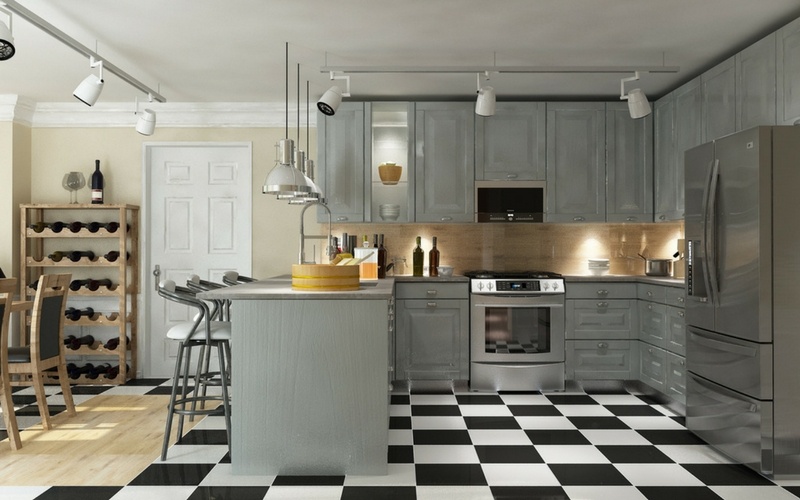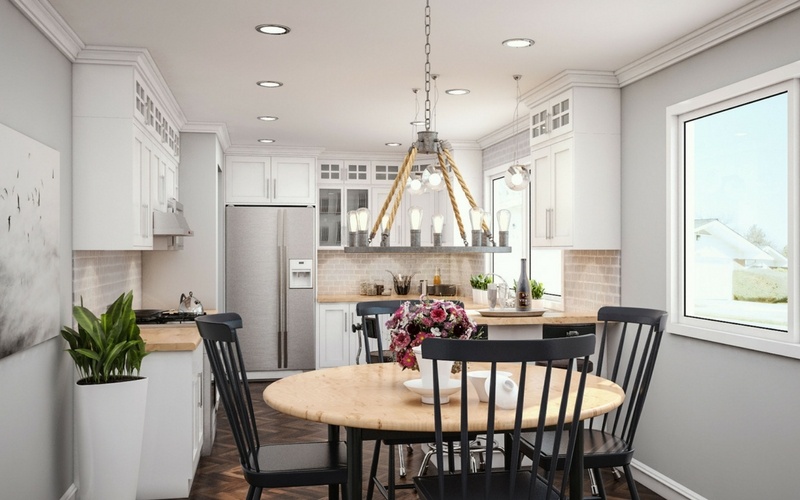There are a number of reasons why a kitchen remodel is more tricky than most other rooms in a house: furniture arrangement is less flexible, high expenditures are required on appliances, and a number of functions have to be accommodated by the layout. However, remodeling a kitchen is also a solid investment as it can drastically increase the value of your property. So, before you get started, check out a few tips that will help you make the process more time- and cost-efficient.
1. Identify the purpose
Before you select a color scheme or even get a contractor, make a list of the different functions of this space. Is the kitchen going to be used solely for cooking or will it also serve as a dining area? Do you have children who will hang out in this area with their friends after school? There are numerous ways in which you will use the space outside of the primary purpose of making meals, so think through each and every one of them and evaluate whether they all can be incorporated in the design or if you have to prioritize.
2. Prioritize your investment
There are items that are worth investing and those that you can try to save on. Of course, if you have your dream budget then there is no reason not to go with top-of-the-line products for everything. However, for the most part it is a puzzle game as we try to put together more expensive pieces with more affordable ones in a nice cohesive image.
Here are a few things that are worth the investment:
- Countertops: quality materials, such as marble, will both last you a very long time as well as increase the value of your home should you decide to sell at one point.
- Proper drainage: there is a lot of waste that we dispose of in the kitchen, often times using a sink – cooking oil, for example. Make sure that you invest in a proper disposal system as well as install quality pipes.
- Energy efficient and smart appliances: if you have to pay more for an energy-efficient appliance – be it a refrigerator or a microwave – do it. You will get this money back in reduced energy bills and, once again, if you ever decide to sell your house together with the appliances, you will be happy that you invested in energy efficiency. When it comes to smart technology, we are not talking about a fancy coffee maker, but rather a smart fire alarm system.
There are also a few items where you can cut corners:
- Hardware finishes: knobs and handles are not worth the investment. When selecting kitchen cabinets, pay attention to the quality of the cabinets, not the design of the knobs on them. You can purchase a different knob or a handle for as little as $4-$5 and it is easy to replace these elements.
- Tiles: porcelain tiles are often recommended for kitchen floors as they resist chipping and cracking, while also being affordable.
READ: HIGH VALUE ROOMS: IMPROVING YOUR KITCHEN TO BOOST HOME VALUE
3. Design based on your habits
How often do you cook? What is your cooking routine? For example, do you tend to cook 3-4 meals at the same time or in portions? How much counter space do you need? How often do you bake? How much food do you freeze? Do you usually cook alone or with another person? These are all the questions you should ask yourself before you remodel your space. No detail is too small. For example, does it make sense for you to create a sub-cooking space where other family members can microwave their food or wash dishes without interfering with your cooking process? How many items do you need to be easily accessible – from pots and pans to a spice rack? Do you purchase in bulks? That will determine the design of your storage space.

4. Pay for the design
Once you have identified what you want and what you want it for, allocate some of your budget for a professional design. Even if you think that you have thought through every possible detail, you will be surprised by how many items you couldn’t even envision that come up when you consult a professional. You may be able to create a pleasant color scheme. A designer will create a stunning one. You may be able to create a detailed storage plane. A designer will figure out how to use dead spaces in the kitchen for storage. You may be able to select quality materials. A designer will explain which materials work best for your maintenance needs. A designer will be able to take your idea and perfect it. This is something worth investing in. The best part is that it can be affordable as well. For example, you can use Arcbazar to crowdsource a dozen of designs from the network of thousands of architects for a fraction of the cost.
5. Evaluate your cleaning vs aesthetic needs
Glass doors on the fridge or cabinets may look gorgeous, but that’s only if you keep them spotless. Are you ready to commit time every week to cleaning them? If the answer is no, then don’t even bother. When selecting appliances and materials for cabinetry, countertops, and floors, you must always think in terms of a balance between their visual appeal and upkeep. Not a single large purchasing decision should be made without such consideration.
6. Identify a focal point
There needs to be a natural flow to your space. Each function needs to be accounted for. However, once you identify those elements and incorporate them in your decision making process, take a step back and try to imagine the end result. What is everything designed around? What is the focal point? Is it the dining area? Is it a kitchen island? Once you have a vision of that, you will need to make design decisions that are in harmony with the focal point. The last thing you want is for your kitchen to feel cluttered and disorganized.

7. Familiarize yourself with current trends, but don’t get caught up in them
It is always advisable to flip through a couple of magazines or a Pinterest board for inspiration before starting on any remodeling project. However, don’t get too obsessed by the sleek trendy designs in these pictures. Do you really need that giant expensive stove you saw on a Pinterest board when the most sophisticated meal you cook is a grilled cheese sandwich? Will you enjoy spending time in a space painted bright yellow and black for the next 5-10 years or will you get tired of the contrasts? Trends come and go, sometimes faster than a remodeling process itself. Timeless pieces and a design authentic to your taste and needs will ensure your satisfaction with the end result.
8. Don’t play too safe either
Don’t be afraid to experiment. We don’t suggest to go with a psychedelic wall design or anything too out of the ordinary, but don’t waste the remodeling opportunity on a boring design that only marginally improves the look and feel of your old kitchen. There is a way to find a balance between experimenting and playing it safe. For example, when it comes to tiles, go with a safer option. They are more expensive and difficult to replace. However, when it comes to a chandelier, you can experiment.
Are there any tips that you could provide based on your experience? Make sure to share them with us and the readers in the comments section below.
READ: 6 THINGS YOU SHOULD KNOW BEFORE REPAINTING
![]()
